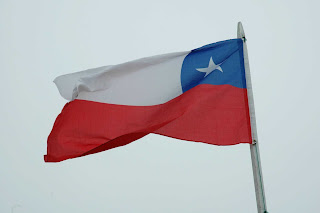
The Pan American Highway starts in Alaska and runs south all the way through Chile to end on the coastal island of Chiloé. For our first excursion we determined to travel the highway as far as the port town of Castro, near the end of the road, and see the sights along the way.


In the resort town of Panguipulli we visited the lattice towered parish church with a statue of the Virgin donated by the town's Arab community, and saw the beach frequented by a summer crowd of Chilean touristas.
 One refreshing beach treat is a drink called a mote con huesillo which is widely available and consists of peach nectar with a helping of softened triticale wheat kernals.
One refreshing beach treat is a drink called a mote con huesillo which is widely available and consists of peach nectar with a helping of softened triticale wheat kernals.


Some local sculpture at
Llanquihue


Salmon hatcheries provide a significant industry in this part of Chile. We saw dozens of trucks like this one loaded with oxygen-fed tanks full of salmon hatchlings being transported from the crystaline streams of the region to coastal fish farms where they will grow to maturity.

A jetboat approaches the Saltos de Petrohué for a spectacular close-up view of the waters pouring out of the Lago Todos Los Santos.

The Volcan Orsono overlooks the lakeside port of Petrohué with it's amazingly blue waters from the dissolved minerals.
 The Lago Todos Los Santos provides one of the ways east through the cordierra to Argentina and the resort area of San Carlos de Bariloche, famed for the five lakes and the winter ski center of Cerro Catedral.
The Lago Todos Los Santos provides one of the ways east through the cordierra to Argentina and the resort area of San Carlos de Bariloche, famed for the five lakes and the winter ski center of Cerro Catedral.
Henry and Jose wish you a Happy Valentine's Day as we get back on the road to continue our journey to the south.
 Henry cheers aboard our ferry crossing the Chacao Channel. We watch the many pelicans, sea lions, and cormorants active alongside the boat. The water is clear and cold.
Henry cheers aboard our ferry crossing the Chacao Channel. We watch the many pelicans, sea lions, and cormorants active alongside the boat. The water is clear and cold. A spectacular view from the road going down the west coast south of Ancud on the way to see the penguin colony on the wonderfully wild Pacific beach of Mar Brava.
A spectacular view from the road going down the west coast south of Ancud on the way to see the penguin colony on the wonderfully wild Pacific beach of Mar Brava.
 Susan shows the seaweed that decorates the beach. Then it's our turn to go out to see the penguinos.
Susan shows the seaweed that decorates the beach. Then it's our turn to go out to see the penguinos.
This contraption that got us out to the launch was supposed to keep our shoes dry, but a series of big waves crashed over the platform and soaked us up to our knees. Once offshore the excitement of seeing both Magellanic and Humboldt penguins nesting together on the Islotes de Punihuil made the whole effort worthwhile.





Sea ducks apparently don't migrate.
After another typical Chilean breakfast at our hotel in Ancud we got back in the truck under ominous gray skies.
We celebrated the excitement of seeing the penguin rookery by posing as a penguin family on vacation.
Then we were off again to travel the coastal road on the east side of the island to spend our last night in Castro, Chile's third oldest city.
 Along the eastern coast of Chiloé are numerous salmon farms that provide many jobs here.
Along the eastern coast of Chiloé are numerous salmon farms that provide many jobs here.

After checking into our hotel, we got totally soaked walking through the rain to eat lunch at Octavio's, a very good seafood restaurant on the harbor where Richard enjoyed his first time eating eel, the house specialty.

 The Castro Cathedral is on UNESCO's World Heritage list and is beautifully constructed of wood with a corrugated metal exterior and molded shingles on the front.
The Castro Cathedral is on UNESCO's World Heritage list and is beautifully constructed of wood with a corrugated metal exterior and molded shingles on the front.
 It was rebuilt in 1912 after being damaged by a cyclone the year before.
It was rebuilt in 1912 after being damaged by a cyclone the year before.Castro is known for its palafitos, houses on stilts over the water, which have become a national monument even though they have been mostly rebuilt with proper sewer connections since the 1960 earthquake.
 The rainy weekend suddenly brightened for our return trip back up the Pan American Highway by a glorious arcoiris, or rainbow, over the Castro fjord.
The rainy weekend suddenly brightened for our return trip back up the Pan American Highway by a glorious arcoiris, or rainbow, over the Castro fjord.








No comments:
Post a Comment